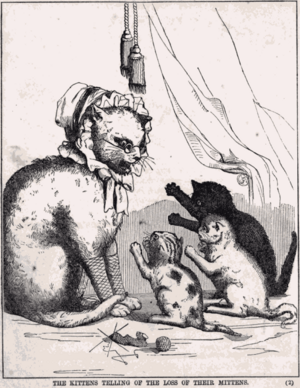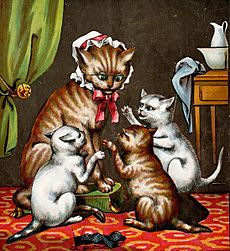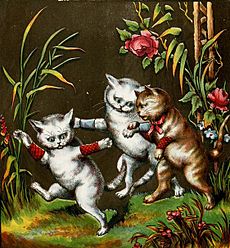Three Little Kittens facts for kids
Quick facts for kids "Three Little Kittens" |
|
|---|---|

Illustration from Ballantyne's 1858 version
|
|
| Nursery rhyme | |
| Published | 1843 |
| Songwriter(s) | Eliza Lee Cabot Follen |
"Three Little Kittens" is a popular English nursery rhyme. It tells the fun story of three kittens who lose their mittens, find them, and then get them dirty. After washing their mittens, they finally get to enjoy some pie!
While the rhyme might have old roots in British folk tales, the version we know today was mostly written by an American poet named Eliza Lee Cabot Follen (1787–1860). Over time, this poem became part of the famous Mother Goose collection of rhymes. It's listed in the Roud Folk Song Index as number 16150, which helps track folk songs and rhymes.
The Story of the Kittens
The rhyme follows the kittens through a series of adventures with their mittens and their mother. It's a playful story that doesn't try to teach a strict lesson, which was different from many children's stories back then. Instead, it uses animals that act like people (this is called anthropomorphic fantasy) and has some silly wordplay.
Here is the most well-known version of the rhyme:
The three little kittens they lost their mittens,
And they began to cry,
Oh, mother dear, we sadly fear
Our mittens we have lost
What? Lost your mittens, you naughty kittens!
Then you shall have no pie.
Mee-ow, mee-ow, mee-ow.
We shall have no pie.
Our mittens we have lost.
The three little kittens they found their mittens,
And they began to smile,
Oh, mother dear, see here, see here,
Our mittens we have found
What? Found your mittens, you good little kittens,
And you shall have some pie.
Mee-ow, mee-ow, mee-ow.
We shall have some pie.
Let us have some pie.
The three little kittens put on their mittens,
And soon ate up the pie;
Oh, mother dear, we greatly fear
Our mittens we have soiled
What? Soiled your mittens, you naughty kittens!
Then they began to sigh,
Mee-ow, mee-ow, mee-ow.
Our mittens we have soiled.
Then they began to sigh.
The three little kittens they washed their mittens,
And hung them out to dry;
Oh! mother dear, look here, look here,
Our mittens we have washed
What? Washed your mittens, you good little kittens,
But I smell a rat close by.
Mee-ow, mee-ow, mee-ow.
We smell a rat close by.
Let's all have some pie.
This version was published by Eliza Lee Cabot Follen in 1843.
Who Wrote the Rhyme?
The rhyme we sing today is usually credited to Eliza Lee Cabot Follen (1787–1860). She was a Sunday school teacher and a writer from Boston, USA. She was also an abolitionist, meaning she worked to end slavery.
Experts believe that Eliza Follen probably didn't create the rhyme completely from scratch. Instead, she likely took an older, simpler version of the poem and made it much better and more polished. By doing this, she made the poem her own. Even though she sometimes said she didn't write it at first, she continued to publish it under her name in later years.
The poem is special because it features cats that act like people, living in a home and needing to report to their mother. This was a new and fun way to write for children back in the 1800s.
How the Rhyme Became Popular
The poem first appeared in print in England in 1827. Later, a version was printed in Britain in 1833 in one of Follen's books. It was added to the book, possibly by the publisher.
The rhyme was first published in the United States in 1843 in Eliza Follen's book called New Nursery Songs for All Good Children. It quickly became a favorite. In 1857, a writer named Cuthbert Bede wrote a story version of the rhyme. The next year, in 1858, R. M. Ballantyne also wrote a story based on Follen's poem and even included music for it. This helped the rhyme become even more widely known and loved.



